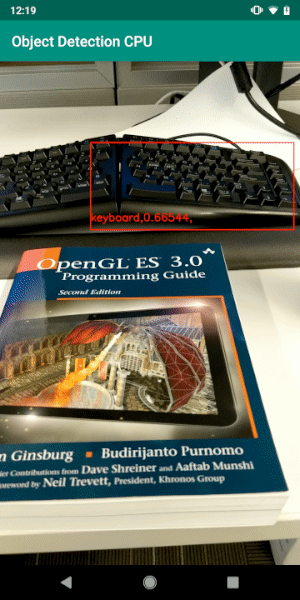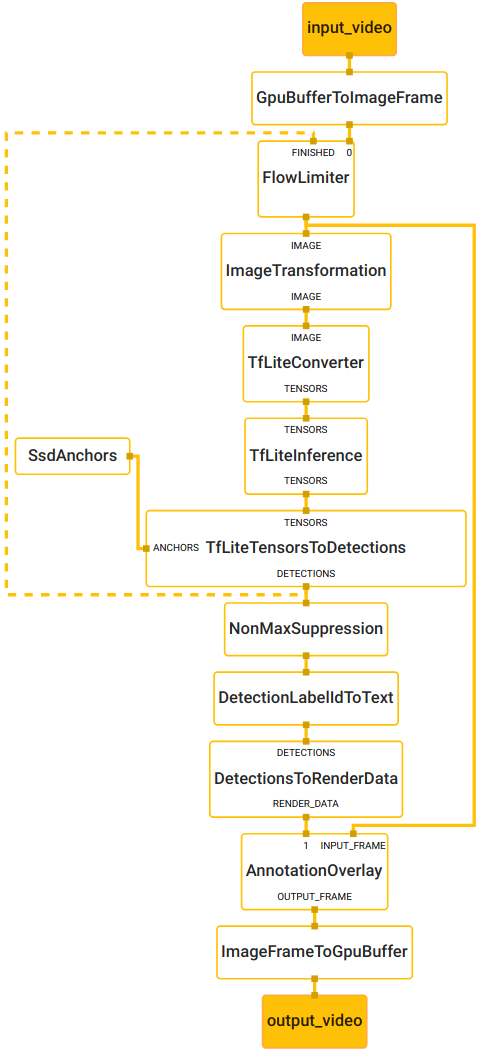8.3 KiB
8.3 KiB
Object Detection (CPU)
This doc focuses on the example graph that performs object detection with TensorFlow Lite on CPU.
This is very similar to the Object Detection on GPU on Android example except that at the beginning and the end of the graph it performs GPU-to-CPU and CPU-to-GPU image transfer respectively. As a result, the rest of graph, which shares the same configuration as the GPU graph, runs entirely on CPU.
Android
To build and install the app:
bazel build -c opt --config=android_arm64 mediapipe/examples/android/src/java/com/google/mediapipe/apps/objectdetectioncpu
adb install bazel-bin/mediapipe/examples/android/src/java/com/google/mediapipe/apps/objectdetectioncpu/objectdetectioncpu.apk
iOS
See the general instructions for building iOS examples and generating an Xcode project. This will be the ObjectDetectionCpuApp target.
To build on the command line:
bazel build -c opt --config=ios_arm64 mediapipe/examples/ios/objectdetectioncpu:ObjectDetectionCpuApp
Graph
To visualize the graph as shown above, copy the text specification of the graph below and paste it into MediaPipe Visualizer.
# MediaPipe graph that performs object detection with TensorFlow Lite on CPU.
# Used in the examples in
# mediapipie/examples/android/src/java/com/mediapipe/apps/objectdetectioncpu and
# mediapipie/examples/ios/objectdetectioncpu.
# Images on GPU coming into and out of the graph.
input_stream: "input_video"
output_stream: "output_video"
# Transfers the input image from GPU to CPU memory for the purpose of
# demonstrating a CPU-based pipeline. Note that the input image on GPU has the
# origin defined at the bottom-left corner (OpenGL convention). As a result,
# the transferred image on CPU also shares the same representation.
node: {
calculator: "GpuBufferToImageFrameCalculator"
input_stream: "input_video"
output_stream: "input_video_cpu"
}
# Throttles the images flowing downstream for flow control. It passes through
# the very first incoming image unaltered, and waits for
# TfLiteTensorsToDetectionsCalculator downstream in the graph to finish
# generating the corresponding detections before it passes through another
# image. All images that come in while waiting are dropped, limiting the number
# of in-flight images between this calculator and
# TfLiteTensorsToDetectionsCalculator to 1. This prevents the nodes in between
# from queuing up incoming images and data excessively, which leads to increased
# latency and memory usage, unwanted in real-time mobile applications. It also
# eliminates unnecessarily computation, e.g., a transformed image produced by
# ImageTransformationCalculator may get dropped downstream if the subsequent
# TfLiteConverterCalculator or TfLiteInferenceCalculator is still busy
# processing previous inputs.
node {
calculator: "FlowLimiterCalculator"
input_stream: "input_video_cpu"
input_stream: "FINISHED:detections"
input_stream_info: {
tag_index: "FINISHED"
back_edge: true
}
output_stream: "throttled_input_video_cpu"
}
# Transforms the input image on CPU to a 320x320 image. To scale the image, by
# default it uses the STRETCH scale mode that maps the entire input image to the
# entire transformed image. As a result, image aspect ratio may be changed and
# objects in the image may be deformed (stretched or squeezed), but the object
# detection model used in this graph is agnostic to that deformation.
node: {
calculator: "ImageTransformationCalculator"
input_stream: "IMAGE:throttled_input_video_cpu"
output_stream: "IMAGE:transformed_input_video_cpu"
node_options: {
[type.googleapis.com/mediapipe.ImageTransformationCalculatorOptions] {
output_width: 320
output_height: 320
}
}
}
# Converts the transformed input image on CPU into an image tensor stored as a
# TfLiteTensor.
node {
calculator: "TfLiteConverterCalculator"
input_stream: "IMAGE:transformed_input_video_cpu"
output_stream: "TENSORS:image_tensor"
}
# Runs a TensorFlow Lite model on CPU that takes an image tensor and outputs a
# vector of tensors representing, for instance, detection boxes/keypoints and
# scores.
node {
calculator: "TfLiteInferenceCalculator"
input_stream: "TENSORS:image_tensor"
output_stream: "TENSORS:detection_tensors"
node_options: {
[type.googleapis.com/mediapipe.TfLiteInferenceCalculatorOptions] {
model_path: "ssdlite_object_detection.tflite"
}
}
}
# Generates a single side packet containing a vector of SSD anchors based on
# the specification in the options.
node {
calculator: "SsdAnchorsCalculator"
output_side_packet: "anchors"
node_options: {
[type.googleapis.com/mediapipe.SsdAnchorsCalculatorOptions] {
num_layers: 6
min_scale: 0.2
max_scale: 0.95
input_size_height: 320
input_size_width: 320
anchor_offset_x: 0.5
anchor_offset_y: 0.5
strides: 16
strides: 32
strides: 64
strides: 128
strides: 256
strides: 512
aspect_ratios: 1.0
aspect_ratios: 2.0
aspect_ratios: 0.5
aspect_ratios: 3.0
aspect_ratios: 0.3333
reduce_boxes_in_lowest_layer: true
}
}
}
# Decodes the detection tensors generated by the TensorFlow Lite model, based on
# the SSD anchors and the specification in the options, into a vector of
# detections. Each detection describes a detected object.
node {
calculator: "TfLiteTensorsToDetectionsCalculator"
input_stream: "TENSORS:detection_tensors"
input_side_packet: "ANCHORS:anchors"
output_stream: "DETECTIONS:detections"
node_options: {
[type.googleapis.com/mediapipe.TfLiteTensorsToDetectionsCalculatorOptions] {
num_classes: 91
num_boxes: 2034
num_coords: 4
ignore_classes: 0
sigmoid_score: true
apply_exponential_on_box_size: true
x_scale: 10.0
y_scale: 10.0
h_scale: 5.0
w_scale: 5.0
min_score_thresh: 0.6
}
}
}
# Performs non-max suppression to remove excessive detections.
node {
calculator: "NonMaxSuppressionCalculator"
input_stream: "detections"
output_stream: "filtered_detections"
node_options: {
[type.googleapis.com/mediapipe.NonMaxSuppressionCalculatorOptions] {
min_suppression_threshold: 0.4
max_num_detections: 3
overlap_type: INTERSECTION_OVER_UNION
return_empty_detections: true
}
}
}
# Maps detection label IDs to the corresponding label text. The label map is
# provided in the label_map_path option.
node {
calculator: "DetectionLabelIdToTextCalculator"
input_stream: "filtered_detections"
output_stream: "output_detections"
node_options: {
[type.googleapis.com/mediapipe.DetectionLabelIdToTextCalculatorOptions] {
label_map_path: "ssdlite_object_detection_labelmap.txt"
}
}
}
# Converts the detections to drawing primitives for annotation overlay.
node {
calculator: "DetectionsToRenderDataCalculator"
input_stream: "DETECTIONS:output_detections"
output_stream: "RENDER_DATA:render_data"
node_options: {
[type.googleapis.com/mediapipe.DetectionsToRenderDataCalculatorOptions] {
thickness: 4.0
color { r: 255 g: 0 b: 0 }
}
}
}
# Draws annotations and overlays them on top of the input images.
node {
calculator: "AnnotationOverlayCalculator"
input_stream: "INPUT_FRAME:throttled_input_video_cpu"
input_stream: "render_data"
output_stream: "OUTPUT_FRAME:output_video_cpu"
}
# Transfers the annotated image from CPU back to GPU memory, to be sent out of
# the graph.
node: {
calculator: "ImageFrameToGpuBufferCalculator"
input_stream: "output_video_cpu"
output_stream: "output_video"
}

